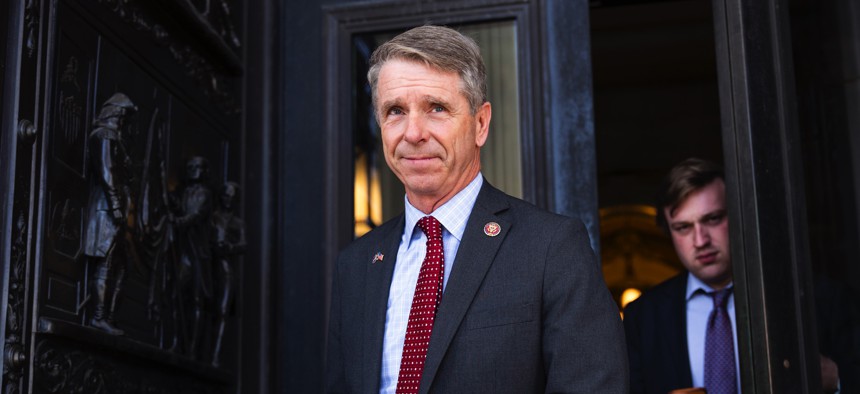
Rep. Rob Wittman, R-Va., leaves the U.S. Capitol on March 30, 2023. Tom Williams/CQ-Roll Call, Inc via Getty Image
As Air Force Tries to Retire Jets, HASC’s Wittman Wants a Gapfiller
The Virginia Republican wants a “tactical interim” capability to arrive while the Air Force awaits its secret NGAD combat aircraft.
The U.S. must improve its forces “to deal with the threats from China,” replenish munitions, invest in energetics, and keep the Air Force’s secret under-development fighter jet on track, says Rep. Rob Wittman, chairman of the House Armed Services’s tactical air and land forces subcommittee.
Wittman, a Republican who represents Virginia’s Tidewater region, previously served as ranking member of the HASC’s seapower and projection forces subcommittee. His new subcommittee oversees Air Force and Army weapons programs.
The subcommittee’s primary goal is to modernize the Pentagon’s tactical air and land forces in a way that doesn’t “give up” capability and capacity, Wittman told Defense One in an interview.
“I want to make sure that we are looking at 'how do we transfer as quickly as possible capability that would go by the wayside as we retire platforms and at least get something in the interim while we're modernizing platforms',” he said.
To fund its research-and-development-heavy budget, the Air Force is asking to retire more than 300 aircraft in fiscal 2024. Most of those cuts are “continuations from existing authorities” the Air Force has already received, but the service must re-request the approvals from lawmakers.
While lawmakers agree that it’s time to give up A-10 Warthogs and F-15-C and -D fighters, Wittman said there must be a “tactical interim” capability that arrives before the Air Force’s Next Generation Air Dominance, or NGAD, jet can be ready.
“The F-22s that they want to retire—specifically to pay for NGAD—I think there's still utility left on those aircraft,” Wittman said. “We're looking at what would you need to do to take that aircraft that's constructed as a trainer but still be able to use its fifth-gen capability in a combat classification.”
On munitions, the committee will look at replenishing stockpiles “in a smart way” and invest in weapons that will make a difference in the Pacific, such as the Joint Air-to-Surface Standoff Missile, or JASSM, and Long-Range Anti-Ship Missile, or LRASM, he said.
“As we're using down the stockpiles, this is a perfect time to modernize, especially for a lot of these weapons systems’ production lines that are actually out of production. I understand that we may need to produce some as an interim…but what a great opportunity now to modernize those platforms,” Wittman said.
Wittman said he also wants to improve U.S. energetics—the propellants and explosives in all of the Pentagon’s weapons.
It’s an issue that needs to be raised to a “level of importance within the Secretary of Defense,” he said. “We have got to kick it into gear to modernize our energetics, because if we're going to be keeping up with the Chinese, range becomes an issue and lethality becomes an issue and we're getting out-sticked by the Chinese almost at every turn.”
The subcommittee will also focus on keeping NGAD on track and ask the service how the pieces of its “family of systems” come together, Wittman said. The Air Force’s NGAD effort includes “collaborative combat aircraft,” or CCAs—drones to accompany the fighters into conflict.
“I think there's some great opportunities here. We have partners like Australia that are already putting in place an unmanned platform that would be a perfect fit on CCA for NGAD—the loyal wingman program they're doing with Boeing,” he said.
The Air Force is asking Congress for $1.9 billion in 2024 for the NGAD program and $500 million for collaborative combat aircraft.
Wittman is also watching the Army’s Future Long-Range Assault Aircraft, or FLRAA, and Future Attack Reconnaissance Aircraft, or FARA, programs, which will be “incredibly important” as the service replaces its rotor-wing aircraft.
On tanker aircraft, Wittman said he will ask Air Force leaders about the service’s decision to shrink its next purchase of tankers and its likely plans to buy the KC-46 instead of holding a competition. The service will buy only 75 tankers in its upcoming “Bridge Tanker” tranche, down from the “up to 160” Air Force Secretary Frank Kendall previously talked about.
“I very much prefer a competition. I think Secretary Kendall does too,” he said, adding that a “technology bridge, some kind of self-protect systems” is necessary for a tanker that will be refueling NGAD, and he’s concerned that the decision to decrease the bridge tanker buy will mean the Air Force is not addressing that risk.
“I think those tankers are going to be asked to operate in environments that are more and more at risk. The question is if you're going to be tanking a future aircraft like NGAD in an area that's going to be highly contested—what do you do in [a] next-generation tanker to do some self protec[ion]?”
NEXT STORY: Can F-35 Engine Plan Get Foreign OK?




